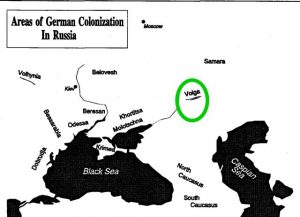German Russians of Ellis County, Oklahoma Territory
22
“Among the millions of mid- to late-nineteenth century immigrants arriving in the United States from Europe were ethnic Germans who had immigrated to Russia in the 1765–1824 period. Poland’s rulers had encouraged Germans to settle in the province of Volhynia (between the Dnieper and Dniester rivers, part of Russia by 1797), and Russian rulers, including Catherine the Great, had promoted settlement along the Volga River (north of the Caspian Sea) and on the coast of the Black Sea and Sea of Azov beginning in 1750. As a result, in the 1760s groups began leaving various German principalities where wars, invasions, high taxes, and military conscription made life unbearable. Colonists arrived in the steppes (plains) when the Russian czars offered them free land, exemption from military service and taxation, and, to an extent, religious liberty. Between 1763 and 1862 an estimated one hundred thousand Germans moved to Russia, including Evangelical Lutherans, Roman Catholics, Baptists, and Seventh Day Adventists.” [1]

“Living on the steppes, they continued to farm, primarily raising wheat, and adapted their system of agriculture to the new environment. They lived in compact villages, built partially subterranean houses similar to half-dugouts, and burned dried manure for fuel. These transplanted Germans prospered. By the middle of the nineteenth century most families owned land, and some were grain merchants or mill owners. The German colonists had become the most advanced agricultural group in Russia. Seldom mixing with or marrying their hosts, the Germans in Russia retained their culture and perpetuated it through their own educational system.
In the 1860s, however, their lives began to change. Czar Alexander II began to draft them into the army, and in the 1880s Alexander III began a “Russification” policy to establish better administrative control over the colonies. Volga Germans began leaving for the United States in the late 1870s, and Mennonites began moving in the 1880s, as did Black Sea and Volhynia Germans. The Great Plains of the Dakotas, Nebraska, and Kansas, markedly similar to the Russian steppes, became populated by them. …
Many moved on into the plains of Oklahoma and Texas. … Land was the factor that drew them southward into Oklahoma Territory. They were poor, and in Kansas they were forced to rent farm land. Beginning in 1889, when public lands were offered for homesteads in Oklahoma, they quickly took advantage of the opportunity to own farms. .. German-Russians were also among the thousands who made the dash into the Cherokee Outlet in September 1893.”[1]
Notes
- Dianna Everett. GERMANS FROM RUSSIA. Oklahoma Historical Society. Downladed from: http://www.okhistory.org/publications/enc/entry.php?entry=GE008 October 26, 2017.
- Germans From Russia, GENEALOGICAL RESEARCH OUTLINE, Family History Library. Down Loaded from http://files.lib.byu.edu/family-history-library/research-outlines/Europe/GermansFromRussia.pdf October 26, 2017.
